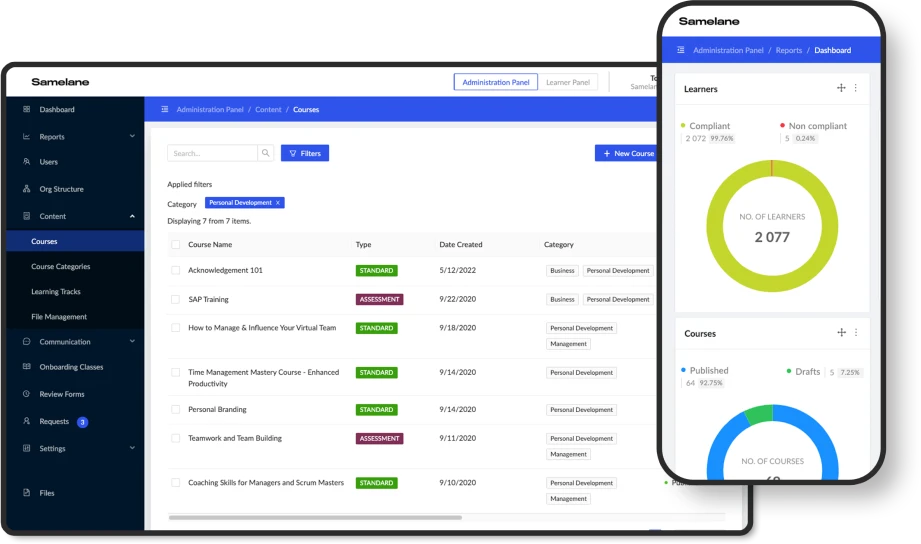Understanding and harnessing the power of motivation is crucial for organizations seeking to thrive and excel. Employee motivation is the driving force behind workplace performance, creativity, and overall satisfaction. By fostering a motivated and engaged workforce, companies can cultivate a culture of innovation, collaboration, and growth. However, motivation is not a one-size-fits-all concept, and recognizing the different types of motivation is essential to tapping into its full potential. This article delves into the diverse types of motivation in the workplace, emphasizing the importance of understanding and nurturing various motivational styles. We will also explore how Learning Management System can foster employee motivation by providing tailored learning experiences, personal growth opportunities, and performance enhancement tools. Join us as we unpack the fascinating world of motivation and discover how LMS can help unleash the full potential of your employees.
Motivation in the workplace
Motivation is a key driver of employee performance and success in the workplace. Various types of motivation can influence employee behavior and engagement, including intrinsic and extrinsic motivation. In this article, we will explore the different types of motivation in the workplace, the benefits of a motivated workforce, and how an LMS can help support and enhance employee motivation. By understanding the different types of motivation and how to foster it in the workplace, organizations can create a culture of motivation and drive success.
Why do we need motivation at work, and where to find it?
Motivation is essential in the workplace because it inspires employees to achieve their goals, stay focused, and remain engaged. When employees are motivated, they are more likely to perform well, be productive, and contribute to the organization’s success. Motivation is also crucial for job satisfaction and employee retention. When employees are motivated, they are more likely to enjoy their work and feel fulfilled. As a result, it can increase job satisfaction and a lower turnover rate, as employees are less likely to leave a rewarding job. To find motivation at work, employees can focus on their personal goals and how their work contributes to those goals. They can also seek opportunities for growth and development, such as training and education programs. Additionally, managers can use motivation in management by creating an encouraging work environment, providing clear goals, recognizing achievements, and offering employee input and feedback opportunities.

counter the Big Quit with high retention strategies
Types of motivation
Employee motivation is the driving force that stimulates employees to perform at their best and contribute to the organization’s success. Motivated employees are willing to put in extra effort and are more likely to be productive, creative, and engaged. Effective employee motivation strategies can help organizations create a positive work environment, improve employee morale and job satisfaction, reduce turnover rates, and increase productivity and profitability. We deal with diverse types of employee motivation; let’s take a closer look at each of them.
1. Intrinsic Motivation
Intrinsic motivation occurs when employees are motivated by internal factors that align with their ikigai, and bring joy, such as personal growth, job satisfaction, connection with colleagues, and a sense of achievement. Intrinsically motivated employees are more likely to be engaged in their work, take ownership of their tasks, and feel a sense of pride in their work. Managers can foster intrinsic motivation by offering opportunities for personal and professional development, recognizing employee achievements, and providing challenging work assignments.
2. Extrinsic Motivation
We deal with extrinsic motivation when employees are motivated by external factors such as rewards, recognition, and bonuses. Extrinsically motivated employees may focus more on the outcome than the process. Managers can use extrinsic motivation to incentivize employees to achieve specific goals or complete projects within a particular timeframe. However, over-reliance on extrinsic motivation can lead to employees needing more intrinsic motivation and creativity.
3. Social Motivation
Social motivation happens when employees are motivated by their relationships with others, such as colleagues and managers. Socially motivated employees are more likely to collaborate, communicate effectively, and feel a sense of belonging in the workplace. Managers can foster social motivation by promoting a positive work culture, encouraging team-building activities, and providing opportunities for feedback and recognition.
4. Achievement Motivation
Achievement motivation occurs when employees are motivated by the desire to achieve specific goals or outcomes. Employees who are achievement motivated are often highly self-driven, goal-oriented, and focused on results. Managers can foster achievement motivation by setting clear goals and expectations, providing feedback and recognition, and offering opportunities for professional development and career advancement.
5. Power Motivation
We deal with power motivation when employees are motivated by the desire for power and control. Power-motivated employees may be more likely to seek leadership roles or positions of authority. Managers can foster power motivation by offering opportunities for leadership and decision-making, providing clear paths for career advancement, and recognizing and rewarding leadership skills.
How can LMS help with employee motivation in the workplace?
A Learning Management System software application helps organizations manage and deliver training and development programs. In addition, LMS can help with employee motivation in the workplace by providing personalized learning opportunities, tracking employee progress and performance, and offering opportunities for feedback and recognition. LMS can also help managers to foster intrinsic motivation by providing customized learning opportunities that align with employee interests and career goals. It can make employees feel valued and supported in personal and professional development. Motivating employees in the workplace is critical for achieving business goals and driving employee engagement and productivity. By providing personalized learning paths, gamification features, progress tracking, flexible learning options, and access to resources, LMS platforms can help motivate employees to engage in professional development and ultimately improve their performance in the workplace.
LMS facilitates all types of motivation
Employee motivation is crucial for the success of any organization. There are different types of employee motivation, which we have discussed in this article, and each of them requires a different approach. However, one effective way to motivate employees is by using LMS as a tool to facilitate employee engagement. Learning platforms offer personalized learning, gamification features, progress tracking, flexible learning options, and easy resource access. By leveraging these features, LMS platforms can help organizations create a culture of continuous learning and professional development, which can ultimately lead to improved employee performance and organizational success. By embracing the power of LMS, organizations can enhance employee motivation and drive better results.












